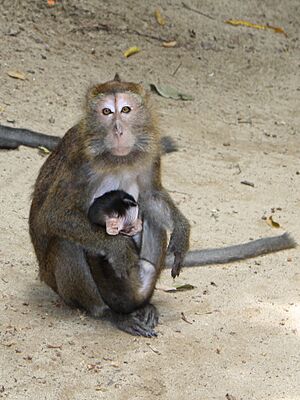Philippine long-tailed macaque facts for kids
Quick facts for kids Philippine long-tailed macaque |
|
|---|---|
 |
|
| Philippine long-tailed macaque in Palawan, Philippines | |
| Conservation status | |
| Scientific classification |
|
| Kingdom: | Animalia |
| Phylum: | Chordata |
| Class: | Mammalia |
| Order: | Primates |
| Suborder: | Haplorhini |
| Infraorder: | Simiiformes |
| Family: | Cercopithecidae |
| Genus: | Macaca |
| Species: | |
| Subspecies: |
M. f. philippensis
|
| Trinomial name | |
| Macaca fascicularis philippensis I. Geoffroy, 1843
|
|
The Philippine long-tailed macaque (Macaca fascicularis philippensis) is a type of monkey that lives in the Philippines. People in the Philippines often call it matsing or unggoy. These monkeys are found in the forests and woodlands of the Philippines. They especially like the mangrove forests in the western central part of the country. You can see them in places like Palawan, the Visayas, and Mindanao.
What They Look Like
The Philippine long-tailed macaque has fur that is reddish-brown. These monkeys can grow to be about 89 to 120 centimeters (35 to 47 inches) long. Their tails are quite long, usually measuring 44 to 60 centimeters (17 to 24 inches).
Male macaques are heavier than females. Males typically weigh between 4 and 8 kilograms (9 to 18 pounds). Females are smaller, weighing only about 3 to 4 kilograms (7 to 9 pounds). Like most primates (monkeys, apes, and humans), these macaques eat many different kinds of food. This means they are omnivorous, eating both plants and small animals.
Where They Live
The Philippine long-tailed macaque lives on many islands in the Philippines. You can find them on islands such as Balabac, Basilan, Bohol, Busuanga, and Luzon. They also live on Mindanao, Mindoro, Palawan, and Samar. These monkeys can live in different environments, even high up in the mountains. They have been found at elevations of up to 1,800 meters (about 5,900 feet).
Ancient Discoveries
Scientists have found fossils of the Philippine long-tailed macaque in Palawan. Along with these monkey fossils, they also found bones from deer, Palawan bearded pigs, and even a type of Bornean tiger. There were also fossils of small mammals, lizards, snakes, and turtles.
These discoveries show that early humans lived in Palawan a long time ago. They used stone tools and fire. The cuts on the animal bones suggest that early humans hunted these animals for food.
In ancient times, large islands like Borneo might have been connected to Palawan. This could have happened during past glacial periods, when sea levels were much lower.
See also


